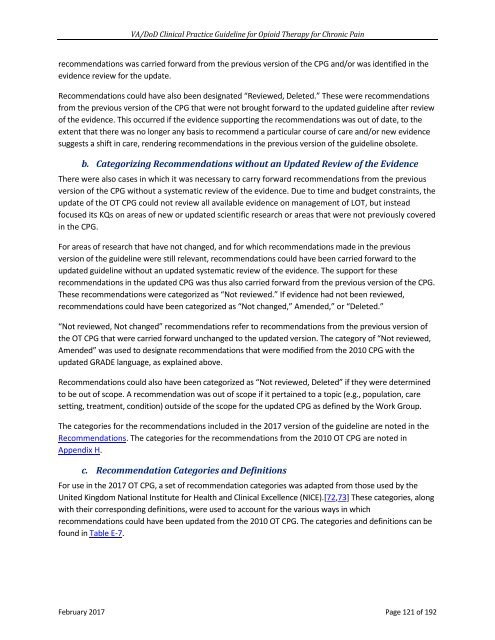VA/DoD CLINICAL PRACTICE GUIDELINE FOR OPIOID THERAPY FOR CHRONIC PAIN
2lfFhbO
2lfFhbO
You also want an ePaper? Increase the reach of your titles
YUMPU automatically turns print PDFs into web optimized ePapers that Google loves.
<strong>VA</strong>/<strong>DoD</strong> Clinical Practice Guideline for Opioid Therapy for Chronic Pain<br />
recommendations was carried forward from the previous version of the CPG and/or was identified in the<br />
evidence review for the update.<br />
Recommendations could have also been designated “Reviewed, Deleted.” These were recommendations<br />
from the previous version of the CPG that were not brought forward to the updated guideline after review<br />
of the evidence. This occurred if the evidence supporting the recommendations was out of date, to the<br />
extent that there was no longer any basis to recommend a particular course of care and/or new evidence<br />
suggests a shift in care, rendering recommendations in the previous version of the guideline obsolete.<br />
b. Categorizing Recommendations without an Updated Review of the Evidence<br />
There were also cases in which it was necessary to carry forward recommendations from the previous<br />
version of the CPG without a systematic review of the evidence. Due to time and budget constraints, the<br />
update of the OT CPG could not review all available evidence on management of LOT, but instead<br />
focused its KQs on areas of new or updated scientific research or areas that were not previously covered<br />
in the CPG.<br />
For areas of research that have not changed, and for which recommendations made in the previous<br />
version of the guideline were still relevant, recommendations could have been carried forward to the<br />
updated guideline without an updated systematic review of the evidence. The support for these<br />
recommendations in the updated CPG was thus also carried forward from the previous version of the CPG.<br />
These recommendations were categorized as “Not reviewed.” If evidence had not been reviewed,<br />
recommendations could have been categorized as “Not changed,” Amended,” or “Deleted.”<br />
“Not reviewed, Not changed” recommendations refer to recommendations from the previous version of<br />
the OT CPG that were carried forward unchanged to the updated version. The category of “Not reviewed,<br />
Amended” was used to designate recommendations that were modified from the 2010 CPG with the<br />
updated GRADE language, as explained above.<br />
Recommendations could also have been categorized as “Not reviewed, Deleted” if they were determined<br />
to be out of scope. A recommendation was out of scope if it pertained to a topic (e.g., population, care<br />
setting, treatment, condition) outside of the scope for the updated CPG as defined by the Work Group.<br />
The categories for the recommendations included in the 2017 version of the guideline are noted in the<br />
Recommendations. The categories for the recommendations from the 2010 OT CPG are noted in<br />
Appendix H.<br />
c. Recommendation Categories and Definitions<br />
For use in the 2017 OT CPG, a set of recommendation categories was adapted from those used by the<br />
United Kingdom National Institute for Health and Clinical Excellence (NICE).[72,73] These categories, along<br />
with their corresponding definitions, were used to account for the various ways in which<br />
recommendations could have been updated from the 2010 OT CPG. The categories and definitions can be<br />
found in Table E-7.<br />
February 2017 Page 121 of 192


